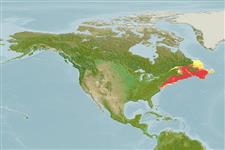Environment / Climate / Range
Ecology
Marine; demersal; depth range 27 - 364 m (Ref. 5951), usually 36 - 91 m (Ref. 5951). Temperate, preferred 7°C (Ref. 107945); 54°N - 37°N
Northwest Atlantic: southern Labrador, Canada to Chesapeake Bay, USA.
Length at first maturity / Size / Weight / Age
Maturity: Lm 29.8 range ? - ? cm
Max length : 64.0 cm TL male/unsexed; (Ref. 7251); max. published weight: 1.5 kg (Ref. 9988); max. reported age: 12 years (Ref. 6286)
Adults inhabit sandy to muddy bottoms (Ref. 7251). Prefer depths of 37 to 82 m at temperatures of 3-5°C (Ref. 6263). Feed mainly on polychaete worms and amphipods, shrimps, isopods and other crustaceans and occasionally small fish such as sand lance and capelin (Ref. 12232). Batch spawner (Ref. 51846). Marketed fresh or frozen; eaten steamed, fried, microwaved and baked (Ref. 9988).
Cooper, J.A. and F. Chapleau, 1998. Monophyly and intrarelationships of the family Pleuronectidae (Pleuronectiformes), with a revised classification. Fish. Bull. 96(4):686-726. (Ref. 30193)
IUCN Red List Status (Ref. 115185)
CITES (Ref. 94142)
Not Evaluated
Threat to humans
Harmless
Human uses
Fisheries: commercial; aquaculture: experimental
Tools
Special reports
Download XML
Internet sources
Estimates of some properties based on models
Phylogenetic diversity index (Ref.
82805): PD
50 = 0.5156 [Uniqueness, from 0.5 = low to 2.0 = high].
Bayesian length-weight: a=0.00912 (0.00447 - 0.01861), b=3.09 (2.92 - 3.26), in cm Total Length, based on LWR estimates for this (Sub)family-body shape (Ref.
93245).
Trophic Level (Ref.
69278): 3.3 ±0.1 se; Based on diet studies.
Resilience (Ref.
69278): Medium, minimum population doubling time 1.4 - 4.4 years (rm=0.69; K=0.3; tm=2-6; tmax=12).
Prior r = 0.5, 2 SD range = 0.25 - 0.99, log(r) = -0.69, SD log(r) = 0.35, Based on: 16 tgen, 1 tmax, 3 Fec records
Vulnerability (Ref.
59153): Moderate vulnerability (37 of 100) .
